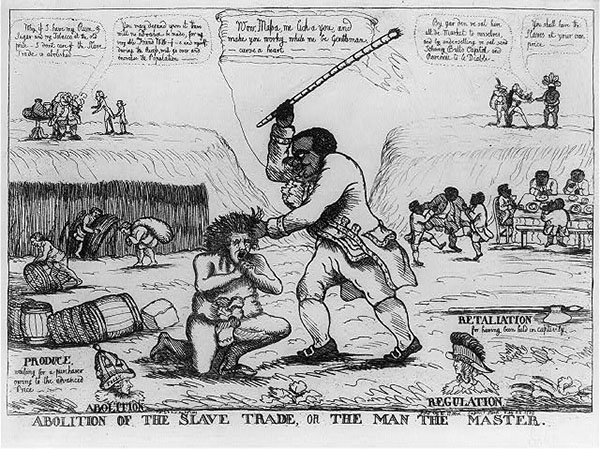The U.S. Constitution had failed to free a lot of slaves throughout most of the 19th Century. How could the Revolutionary leaders have allowed this?
Vermont abolished slavery in 1777. Many Northern states soon followed suit. Even Virginia wanted to soften and end slavery someday. The slaveholders in that state and Maryland treated their slaves with more compassion than those in South Carolina and Georgia. Right before the Revolution, many slaveholders allowed their slaves to visit their families on other plantations, not minding if they were late getting back to their masters nor being away for days or even weeks. Since there were no free states for slaves to go to, they had nowhere to run to.
In the Upper South, the black codes that had been passed at the beginning of the 18th century had been neglected. Whites became less concerned with racial separation than before. Whites and Blacks got along better in the latter part of the century than in the beginning. Slaves and lower-class whites drank together in saloons, gambled together, and more. Blacks usually played music for whites at dances. All in all, whites treated the few free blacks much better than they would later in the 19th century. Free blacks were allowed to to buy and keep property, carry weapons in militia groups, travel quite freely and even vote in some areas. White Protestant Evangelicals like the Baptists and Methodists invited blacks to join their congregations. Even black preachers spoke at white churches. Southerners like Jefferson and Patrick Henry started speaking out publicly against the injustices of slavery.
Hope for Slavery
In the Upper South, plantation owners started hiring black to work their fields and in their homes instead of using slaves, or started paying their slaves. Many thought that slavery, in general, would be replaced by paid labor. The creation of more anti-slavery societies in the South than in the North, made many people think that the South was would follow the North on the slavery issue. In Virginia and Maryland, many anti-slavery societies brought suits against slaveholders. If slaves could prove that they had white or Indian ancestry on their mother’s side of the family, than the court would grant them freedom, even with little evidence. Whole families’ fate could depend on a single court decision. By 1790 the population of free blacks had increased to over 30,000. Many thought that the end of slavery was just a matter of time; shortly.
The Constitution restricted the slave trade to only slaves brought into the states until 1808. In 1798, Congress prohibited the importation of slaves from abroad into the Mississippi Territory but allowed the slaves to enter the Western territories from elsewhere in the U.S. Slaves were in significant demand in the Southwest territories that the restrictions on slavery were short-lived. Soon, slaves were flowing into the Southwest not only from other parts of the U.S. (states or territories) but also from Africa itself.
The main reason why so many Americans thought that slavery was so close to extinction in America was because they thought it was so wrong. Everywhere in the Western hemisphere, slavery was dependent on the constant importation of slaves from Africa – except for most of North America. They thought that the slave trade itself would end and thus end slavery. But some in the Upper South thought that the abolition of the slave trade would not end slavery because of the current problem with slaves already in captivity. Northerners didn’t appreciate that slavery in the South was a healthy, vigorous and expansive institution.. The Constitution drafted in 1787, gave South Carolina and Georgia 20 years to import more slaves from abroad. Most people thought that the Congress would end the slave trade in 1808, ending slavery itself. In fact, all states except South Carolina, stopped importing slaves on their own during the 1790s.
With slavery disappearing steadily in the North and continuing in the South, the U.S. was moving in two opposite directions.
The Failure of the Constitution
The Constitution of 1787 had a clause that counted slaves as three-fourths of a person in levying taxes and for assessing representation in the House of Representatives and the Electoral College. The federal government had seldom taxed people directly and was unlikely to do so quite often. Therefore, representation was a big issue that people had at that time. In the Constitutional Convention that year, aristocratic Gouverneur Morris criticized the three-fifths clause as unjust and that it gave the slave states an excuse to import more slaves. But the Convention overwhelmingly rejected his call to not count slaves at all in reapportionment and taxing. Only New Jersey voted for it. After the proposal was defeated, there was another that slaves be counted as a whole person but that one was defeated as well. Caught between the proposal to counting the slaves fully and not counting them, the Convention wrote the three-fifths compromise into the Constitution. Most Northern Federalists accepted the compromise as a reluctant necessity in order to keep the South in the Union. But with the rise of the Democratic-Republican opposition in the 1790’s that elected Jefferson president and dominated Congress in 1800, the Federalists changed their minds. They realized that the Democratic-Republican Party was Southern based and that it depended on the slave-holding leadership. Since Jefferson had won with 82% of the electoral vote of slave states, and only 27% of Northern states, Federalists had reason to fear that the South was starting to control the U.S. The Federalists started to think that the South’s over-representation in Congress and the Electoral College made them feel displaced in the national government.
References:
- Wood, Gordon S. Empire of Liberty – A History of the Early Republic, 1789-1815. 2009. Pages 519, 524 -526, 532-533.








